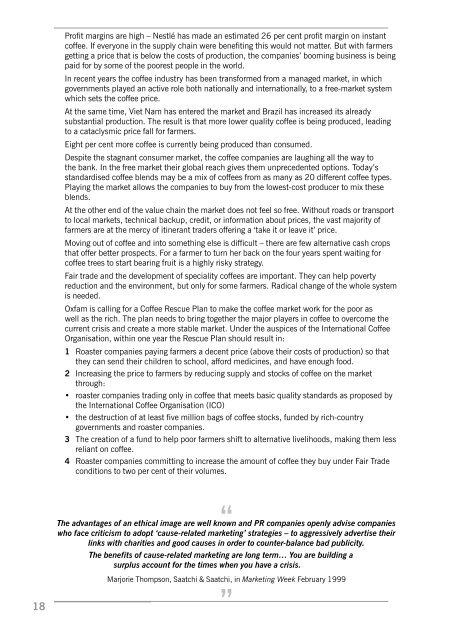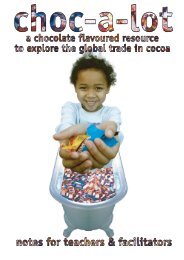Cost of coffee.indd - RISC
Cost of coffee.indd - RISC
Cost of coffee.indd - RISC
Create successful ePaper yourself
Turn your PDF publications into a flip-book with our unique Google optimized e-Paper software.
Pr<strong>of</strong>it margins are high – Nestlé has made an estimated 26 per cent pr<strong>of</strong>it margin on instant<br />
c<strong>of</strong>fee. If everyone in the supply chain were benefiting this would not matter. But with farmers<br />
getting a price that is below the costs <strong>of</strong> production, the companies’ booming business is being<br />
paid for by some <strong>of</strong> the poorest people in the world.<br />
In recent years the c<strong>of</strong>fee industry has been transformed from a managed market, in which<br />
governments played an active role both nationally and internationally, to a free-market system<br />
which sets the c<strong>of</strong>fee price.<br />
At the same time, Viet Nam has entered the market and Brazil has increased its already<br />
substantial production. The result is that more lower quality c<strong>of</strong>fee is being produced, leading<br />
to a cataclysmic price fall for farmers.<br />
Eight per cent more c<strong>of</strong>fee is currently being produced than consumed.<br />
Despite the stagnant consumer market, the c<strong>of</strong>fee companies are laughing all the way to<br />
the bank. In the free market their global reach gives them unprecedented options. Today’s<br />
standardised c<strong>of</strong>fee blends may be a mix <strong>of</strong> c<strong>of</strong>fees from as many as 20 different c<strong>of</strong>fee types.<br />
Playing the market allows the companies to buy from the lowest-cost producer to mix these<br />
blends.<br />
At the other end <strong>of</strong> the value chain the market does not feel so free. Without roads or transport<br />
to local markets, technical backup, credit, or information about prices, the vast majority <strong>of</strong><br />
farmers are at the mercy <strong>of</strong> itinerant traders <strong>of</strong>fering a ‘take it or leave it’ price.<br />
Moving out <strong>of</strong> c<strong>of</strong>fee and into something else is difficult – there are few alternative cash crops<br />
that <strong>of</strong>fer better prospects. For a farmer to turn her back on the four years spent waiting for<br />
c<strong>of</strong>fee trees to start bearing fruit is a highly risky strategy.<br />
Fair trade and the development <strong>of</strong> speciality c<strong>of</strong>fees are important. They can help poverty<br />
reduction and the environment, but only for some farmers. Radical change <strong>of</strong> the whole system<br />
is needed.<br />
Oxfam is calling for a C<strong>of</strong>fee Rescue Plan to make the c<strong>of</strong>fee market work for the poor as<br />
well as the rich. The plan needs to bring together the major players in c<strong>of</strong>fee to overcome the<br />
current crisis and create a more stable market. Under the auspices <strong>of</strong> the International C<strong>of</strong>fee<br />
Organisation, within one year the Rescue Plan should result in:<br />
1 Roaster companies paying farmers a decent price (above their costs <strong>of</strong> production) so that<br />
they can send their children to school, afford medicines, and have enough food.<br />
2 Increasing the price to farmers by reducing supply and stocks <strong>of</strong> c<strong>of</strong>fee on the market<br />
through:<br />
• roaster companies trading only in c<strong>of</strong>fee that meets basic quality standards as proposed by<br />
the International C<strong>of</strong>fee Organisation (ICO)<br />
• the destruction <strong>of</strong> at least five million bags <strong>of</strong> c<strong>of</strong>fee stocks, funded by rich-country<br />
governments and roaster companies.<br />
3 The creation <strong>of</strong> a fund to help poor farmers shift to alternative livelihoods, making them less<br />
reliant on c<strong>of</strong>fee.<br />
4 Roaster companies committing to increase the amount <strong>of</strong> c<strong>of</strong>fee they buy under Fair Trade<br />
conditions to two per cent <strong>of</strong> their volumes.<br />
18<br />
“<br />
The advantages <strong>of</strong> an ethical image are well known and PR companies openly advise companies<br />
who face criticism to adopt ‘cause-related marketing’ strategies – to aggressively advertise their<br />
links with charities and good causes in order to counter-balance bad publicity.<br />
The benefits <strong>of</strong> cause-related marketing are long term… You are building a<br />
surplus account for the times when you have a crisis.<br />
Marjorie Thompson, Saatchi & Saatchi, in Marketing Week February 1999<br />
”




